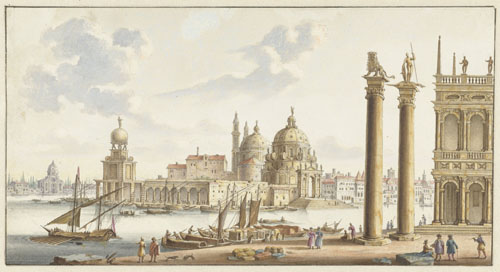
‘View of Sta Maria della Salute, Venice’, by Jan van Call. Before 1699, pencil and water-colour on paper, 12.3 by 23 cm. (Image courtesy of Rijksmueum, Amsterdam, object no. RP-T-1921-54)
For those wishing to play their part on a diplomatic or networking stage there is much to be learnt from the life and death of John Dodington. For two years from 1670 this English agent was based in Venice, where he became an invaluable intermediary between Henry Oldenburg and a number of notable Italian scientists, including Marcello Malpighi and Tommaso Cornelio.
Until recently, Dodington has remained a little-known figure. He was described by A. Rupert and Marie Boas Hall in their edition of Oldenburg’s correspondence as a ‘useful correspondent in Italy . . . to him Oldenburg could dispatch letters for Malpighi and others via official channels.’ But the Halls conceded also, ‘It is not quite certain who Dodington was — though his name figures often enough in the official records — but he was by no means uninterested in the tasks that Oldenburg asked him to perform on the Society’s behalf.’ [A. R. and M. B. Hall, The Correspondence of Henry Oldenburg, vol. VI (1969), pp. xxi–xxii] Indeed it was thanks in no small measure to Dodington that a gulf was breached between Royal Society members in England and their scientific counterparts in Italy, a country which (again in the words of the Halls) may have seemed to Oldenburg ‘almost as remote in an epistolary sense as Bermuda … or Connecticut.’ [A, R, and M. B. Hall, vol. III (1969), p. xxv] The role Dodington performed for Oldenburg has been charted by Oxford’s professor of the History of Science, Robert Iliffe [see ‘Making Correspondents Network. Henry Oldenburg, Philosophical Commerce, and Italian Science, 1660–72′, in Marco Beretta, Antonio Clericuzio, and Lawrence M. Principe, eds, The Accademia del Cimento and its European Context (Sagamore Beach, MA, 2009), pp. 211–28], and given the relationship and exchange of letters between the two men — fourteen letters from Oldenburg to Dodington are calendared in EMLO, and fifteen from Dodington to Oldenburg — it is fitting that this calendar of Dodington’s correspondence should be published at the same time as the release of metadata for a further two volumes of the Halls’ edition of Oldenburg’s letters.
The French scholar Alexandre J. Tessier worked on Dodington’s correspondence in connection with his doctoral studies on Sir Joseph Williamson and has contributed this calendar to EMLO. At present, Dr Tessier is focussing on the European postal system of the late-seventeenth and early eighteenth centuries, and, revisiting Dodington’s letters, he has collated and noted additional information such as dates of receipt. Here at EMLO we are in the process of investigating how best to capture and display such detailed information, together with a number of other postal-related fields (for example: location stamps; notes on a letter’s routes; reasons for non-delivery; or postage costs). Our partners in this work include both Dr Tessier and the invaluable Signed, Sealed, and Undelivered project based at the Museum voor Communicatie in The Hague.
Dodington seems to have been more successful in his scientific networking activities than he proved in his diplomatic roles. As an individual, he gives the impression of having been touchy, tactless, and irascible — not, as Dr Tessier points out in his introductory summary of Dodington’s life, characteristics that sit well in a diplomat or are suited to ambassadorial activity. Dodington fell out with his (admittedly difficult) father; he spent a spell in the Tower (following his insult of a Bencher of Lincoln’s Inn with ‘opprobrious and misbecominge language’); he was recalled from his post as resident in Venice after an accumulation of complaints (including an incident that involved his slander of Louis XIV in a Savoyard inn); and he met his end as the result of a drinking session in a London tavern: ‘With two other gentlemen he consumed five quarts of wine at the Bear, in Leadenhall Street, and as the King’s letter-carrier, Thomas Derham, wrote to Williamson, they “fell immediately after drinking it into high fevers and deliriums, of which Mr. Dodington and another died”’. [Lloyd Charles Sanders, Patron and place-hunter, a study of George Bubb Dodington, Lord Melcombe (London and New York: The Bodley Head and John Lane, 1919), p. 8.]
We hope very much you enjoy exploring Dodington’s correspondence alongside that of an expanded Oldenburg catalogue. Should you have access via a subscribing institution, you will be able to consult (through State papers Online 1509–1714) the manuscripts of Dodington’s letters now in the care of the National Archives. This little tip comes with a final ‘health warning’, however: avoid downing a gallon and a quarter of wine as you read!
